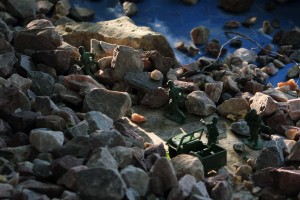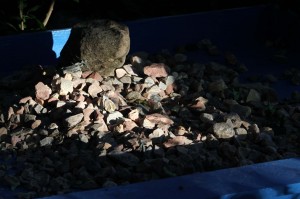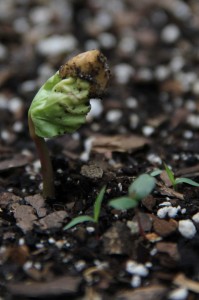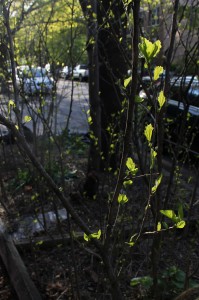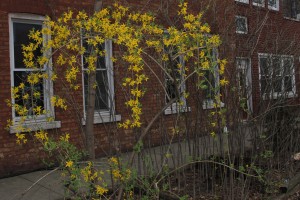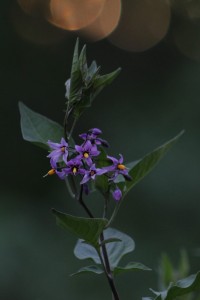 Not sure what plant this is but it keeps coming back on the veranda, west wall, center right container. This is I think year 4 of this plant in that container and its growth has accelerated. I see it growing in neighborhood yards like a weed. The flower turns into some kind of berry. Not sure if it’s poisonous or not.
Not sure what plant this is but it keeps coming back on the veranda, west wall, center right container. This is I think year 4 of this plant in that container and its growth has accelerated. I see it growing in neighborhood yards like a weed. The flower turns into some kind of berry. Not sure if it’s poisonous or not.
Tomatoes in morning light
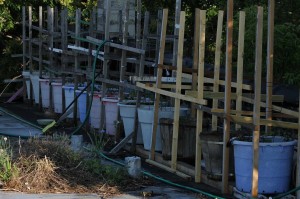 This photo shows the tomatoes at around 7:30 am on 6/3. They’re still shaded nicely. Sunrise is around 5:16am so they get over 2 1/2 hours of morning shade. The south side of the roof gets no shade. The debris clump in the sunlight is suffering from drought. We’ll see how these fare this year under drought conditions. I have identified two leaks in the roof that need repair — exact location not completely known. I do not suspect the debris clumps however. The tomato patch and two corners are the only things growing up there this year giving me room to do some roof repairs. Much of the roof needs that silver paint. I might look into white instead.
This photo shows the tomatoes at around 7:30 am on 6/3. They’re still shaded nicely. Sunrise is around 5:16am so they get over 2 1/2 hours of morning shade. The south side of the roof gets no shade. The debris clump in the sunlight is suffering from drought. We’ll see how these fare this year under drought conditions. I have identified two leaks in the roof that need repair — exact location not completely known. I do not suspect the debris clumps however. The tomato patch and two corners are the only things growing up there this year giving me room to do some roof repairs. Much of the roof needs that silver paint. I might look into white instead.
The following is for log book purposes. The 14 caged positions have been planted with the following:
1 – two Cleome 2 – Celebrity 3 – two eggplants 4 – Big Boy 5 – I’ll fill this in later.
Tomatoes planted
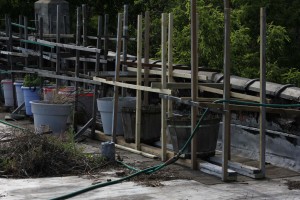 All tomatoes were planted last evening. This shot shows the 5 new caged slots. This year there are a total of 14 caged positions as opposed to only 9 last year. Each 3 cu ft. container got about 1/2 cu. ft. of mushroom compost. To help thwart another outbreak of blight from ruining the entire crop, tomatoes will be separated. Of the 14 positions, tomatoes take only 8 — the other six will be something else. At least two will be Cleome which gets huge and attracts bees. The tomato layout is as follows.
All tomatoes were planted last evening. This shot shows the 5 new caged slots. This year there are a total of 14 caged positions as opposed to only 9 last year. Each 3 cu ft. container got about 1/2 cu. ft. of mushroom compost. To help thwart another outbreak of blight from ruining the entire crop, tomatoes will be separated. Of the 14 positions, tomatoes take only 8 — the other six will be something else. At least two will be Cleome which gets huge and attracts bees. The tomato layout is as follows.
1 2 3 4 5 6 7 8 9 10 11 12 13 14
O T O T T O T T O T T O T O
I put Os at the ends because in past years I have noticed the tomato at the end of the line on each side would suffer from something. We’ll see how well this works.
Also note that the construction of these cages was done ad hoc on site without a square using mostly recycled wood. Although things look crooked and not up to usual carpentry standards, the cages themselves are very sturdy. Nothing penetrates the roof BTW. In a few years when parts wear out I might replace them with cages prebuilt on the ground and at perfect right angles. For now they work. No one but me ever sees these up close anyway.
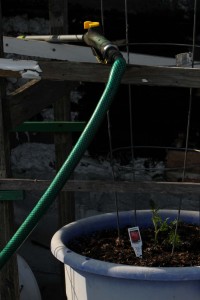
Sunflower sprout
Rock Garden
Moonflower sprouts
The first moon flower sprouts. Moon flower vines produce large white flowers that bloom at night after dusk in late August. I didn’t get any moon flowers last year — probably because I didn’t plant any. Over the years however I have observed that moon flowers can be picky about sprouting which is why it’s nice to see a sprout.
Out of focus in the forefront is a sunflower. These are sprouting all over now. This is the veranda north wall box.
Here‘s a pic of a moon flower in bloom taken in 2004.
NE corner main roof status
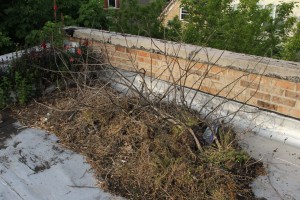 The white box in the corner is badly collapsed and needs replacing. Huge snapdragons are growing out of the sides however and I don’t want to disturb them this year. I don’t know how snapdragons can get so large since I thought they grew from seed every year.
The white box in the corner is badly collapsed and needs replacing. Huge snapdragons are growing out of the sides however and I don’t want to disturb them this year. I don’t know how snapdragons can get so large since I thought they grew from seed every year.
The debris clump in the forefront is in its second year and starting to get green growth. The plant skeletons were put in this year. This debris clump sits at the top of the roof so it gets the least amount of water of all clumps during rains. I suspect that won’t matter since any rain will completely saturate it anyway. In other words, the water going under a debris clump will only matter if that’s part of the irrigation system.


